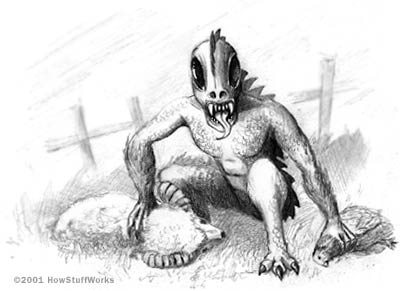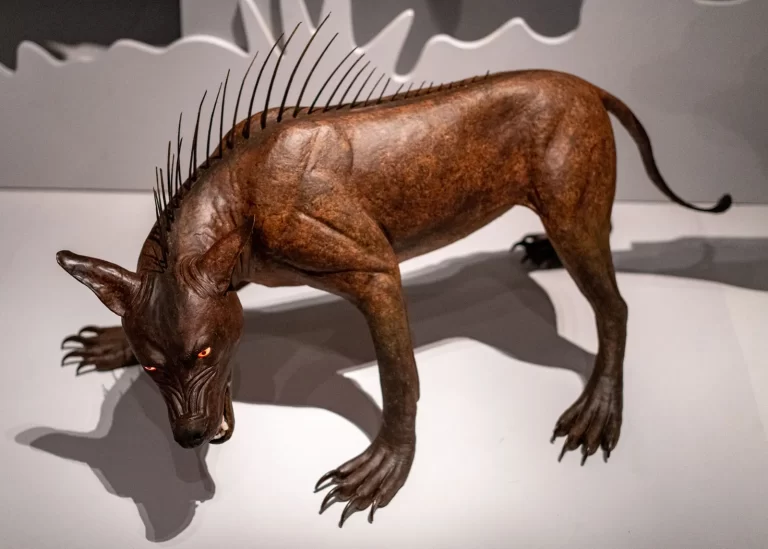In the heart of the mysterious, beneath the veil of night, a creature of legend roams—feared, revered, and enigmatic. It is the Chupacabra, a name that strikes fear into the hearts of rural communities, a creature that defies easy classification. Born from the fertile soil of Latin American folklore, the Chupacabra has transcended its origins to become a cryptid of global renown. But what is the Chupacabra, and where does myth end and reality begin in the complex tapestry of its existence?
In this 4,000-word exploration, we venture into the realm of the Chupacabra, a cryptid whose history is steeped in folklore, whose impact reaches far and wide, and whose existence continues to spark debates among believers and skeptics alike. We delve into the origins of the legend, the chilling accounts of alleged encounters, the scientific and skeptical perspectives, the search for evidence, and the cultural significance that has made the Chupacabra a symbol of the unexplained. Is the Chupacabra a mythical creature that haunts our collective imagination, a genuine threat to rural communities, or a curious blend of both?
The Origins of a Nightmare

To understand the Chupacabra, we must begin at its roots. The term “Chupacabra” is a portmanteau of two Spanish words: “chupar” (to suck) and “cabra” (goat). This name aptly describes the creature’s purported behavior—sucking the blood of livestock, particularly goats and chickens. But where did this legend originate, and how did it spread like wildfire throughout Latin America and beyond?
Puerto Rico: Ground Zero for the Chupacabra
The Chupacabra legend finds its earliest documented roots in Puerto Rico in the mid-1990s. Local farmers reported mysterious deaths of their livestock, attributing them to a strange creature. This creature was described as having reptilian features, sharp fangs, red eyes, and an uncanny ability to drain the blood from its prey. The legend quickly took hold, and eyewitness accounts of Chupacabra sightings began to surface.
The Media Frenzy
The Chupacabra legend spread like wildfire through the media, both locally and internationally. Newspapers and television programs fueled the hysteria, featuring dramatic reenactments and interviews with those who claimed to have encountered the creature. The legend’s rapid dissemination beyond Puerto Rico marked the birth of a new cryptid.
Cultural Transmission
The Chupacabra story didn’t remain confined to Puerto Rico. It made its way to neighboring countries and eventually reached the mainland of the United States. As it traveled, the creature’s description and attributes began to vary, reflecting the cultural diversity of the regions in which the legend took root.
The Chupacabra Chronicles
The Chupacabra quickly became a household name, and sightings of the creature proliferated. Whether it was due to the power of suggestion or genuine belief in its existence, people from different walks of life began reporting Chupacabra encounters. This chapter delves into some of the most intriguing and chilling accounts of alleged Chupacabra encounters.
Eye-Witness Testimonies
Accounts of Chupacabra sightings vary widely. Some describe a creature akin to the original Puerto Rican legend—a reptilian, blood-sucking entity. Others report a more mammalian creature with sharp teeth, a dog-like appearance, and a proclivity for attacking livestock. The locations of these encounters span from the Americas to as far afield as Russia and the Philippines.
Chupacabra Attacks on Livestock
One of the most consistent elements of Chupacabra accounts is the alleged attacks on livestock. Farmers have reported finding their goats, sheep, and chickens dead, often with puncture wounds and a lack of visible blood. These incidents have led to significant economic losses in some regions, exacerbating fears of the mythical creature.
Specimens and Examinations
In certain cases, carcasses of supposed Chupacabras have been discovered and subjected to examination. However, these examinations have yielded no conclusive evidence of a new or unknown species. Instead, the creatures have typically been identified as coyotes, raccoons, or other animals with mange, a skin condition that can give them a peculiar appearance.
The Evolution of a Legend
As the Chupacabra legend continued to evolve and spread, it adapted to the cultural and environmental contexts of the regions it infiltrated. This chapter explores the various iterations and adaptations of the Chupacabra legend, shedding light on the complex nature of folklore.
Mexico: El Chupacabras
In Mexico, the Chupacabra became “El Chupacabras,” taking on a more formidable and menacing persona. Rather than the reptilian creature of Puerto Rico, Mexican accounts described it as a dog-like being with quills or spines along its back. This version of the legend tapped into the rich tradition of “el lobo,” a mythical wolf-like creature, and integrated it with the Chupacabra narrative.
The Texas Chupacabra
In the United States, particularly in the southwestern state of Texas, reports of a Chupacabra began to surface. These sightings described a hairless, dog-like creature with sharp fangs and a thirst for blood. Despite numerous alleged encounters, no concrete evidence has been produced to confirm the existence of a Chupacabra as a distinct species.
Variations Worldwide
As the Chupacabra legend traveled worldwide, it adapted to local cultural and ecological settings. In Russia, accounts of Chupacabra-like creatures emerged, described as mysterious predators with a penchant for attacking livestock. In the Philippines, stories of a similar creature named the “Chiropteran” circulated, suggesting that the Chupacabra had crossed oceans and found a place in local folklore.
The Skeptical Perspective
While the Chupacabra legend continues to captivate the imaginations of many, skeptics have a different viewpoint. They argue that the Chupacabra is not a distinct cryptid but a product of folklore, mass hysteria, and misidentification of mundane animals. In this chapter, we explore the skeptical perspective and the rational explanations put forth.
Misidentified Wildlife
Skeptics posit that many alleged Chupacabra sightings can be attributed to the misidentification of known wildlife. Animals suffering from mange, a condition that causes hair loss and skin abnormalities, often resemble the hairless and “otherworldly” description associated with Chupacabras.
Urban Legends and Mass Hysteria
Urban legends have a remarkable ability to take hold of the collective consciousness. Skeptics argue that the Chupacabra is a prime example of how a compelling narrative can trigger mass hysteria and the spread of a legend, even in the absence of concrete evidence.
Lack of Scientific Evidence
Despite decades of Chupacabra sightings and reports, there is a conspicuous absence of scientific evidence to support the existence of such a creature. Skeptics maintain that the burden of proof rests with those who claim the Chupacabra is a real and distinct species.
Chasing the Chupacabra
While skepticism prevails in the scientific community, there are those who continue to pursue the Chupacabra, driven by a conviction that the creature exists. This chapter explores the efforts to find tangible evidence of the Chupacabra’s existence and the challenges that researchers face.
Cryptozoologists and Chupacabra Expeditions
Cryptozoologists, individuals who study and search for creatures that fall outside the realm of known science, have conducted numerous expeditions in search of the Chupacabra. They venture into regions where sightings have been reported, aiming to find physical evidence or documentation of the creature.
The Role of Citizen Science
In the digital age, citizen science has played a significant role in mystical creature investigations. Ordinary people equipped with cameras and recording devices can document alleged Chupacabra encounters and share their findings with a global audience. However, the vast majority of such encounters lack conclusive evidence.
Beyond Science: The Cultural Significance of the
Beyond the scientific debate, the Chupacabra holds profound cultural significance for the communities in which the legend has taken root. This chapter explores the symbolic and cultural dimensions of the Chupacabra, shedding light on why the legend persists.
Folklore and Identity
Folklore is an essential component of cultural identity. The Chupacabra, with its blend of myth, mystery, and fear, becomes woven into the cultural fabric of the communities where it is believed to exist. It serves as a symbol of the unexplained and the mysterious.
The Power of Belief
Belief in the Chupacabra is a testament to the strength of myth and legend. People who live in areas where the Chupacabra is feared hold fast to their beliefs, drawing strength from the idea that they share their environment with a creature that defies explanation.
The Chupacabra in Popular Culture
The Chupacabra has transcended its origins in folklore to become a prominent figure in popular culture. This chapter explores the ways in which it has been embraced by writers, artists, filmmakers, and the media.
Literature and Art
The mystical creature has left its mark on literature and art. It has appeared in books, short stories, and visual artworks, captivating the imagination of creators. The creature’s mysterious and menacing attributes provide a wealth of material for artists and writers to explore.
Film and Television
The Chupacabra has also made its way into the world of film and television. Numerous movies and television shows have featured the creature as a central element of their plots. These adaptations often play on the fear of the unknown and the creature’s elusive nature.
Conclusion
As we conclude our journey through the fascinating realm of the Chupacabra, we find ourselves at the crossroads of myth and reality, where the enigmatic creature’s existence remains an open question. This legendary beast, born from the depths of folklore and mass hysteria, has fascinated, frightened, and divided communities across the Americas and beyond. It’s a cryptid that refuses to fade into obscurity, stubbornly challenging the boundary between myth and science.
The Chupacabra, whether real or mythical, symbolizes the enduring power of human imagination, the tenacity of folklore, and the intricate interplay between belief and skepticism. It serves as a testament to the human need for mystery and the allure of the unexplained, reminding us that the world is still rich with secrets waiting to be uncovered.
For believers, the creature is more than a legend; it is a living nightmare, a creature that continues to lurk in the shadows of rural landscapes, striking fear into the hearts of those who believe. It is a symbol of the unknown, a testament to the power of local myths and legends that endure for generations.
For skeptics, the Chupacabra is a product of human psychology, the blending of folklore, and the power of suggestion. Its elusiveness is a result of the ambiguity in eyewitness accounts, misidentifications, and a lack of concrete scientific evidence.
The creature’s presence in popular culture, literature, art, and media reveals its lasting impact on the collective imagination. It has transcended its origins in Puerto Rican folklore to become a global icon of the cryptid world. This transformation highlights the human fascination with the mysterious, the eerie, and the otherworldly.
In the end, the Chupacabra embodies the complexities of belief and skepticism, the resilience of myth and folklore, and the enduring allure of the unknown. It is a creature that dwells in the twilight between reality and myth, inviting us to question, wonder, and explore the boundaries of our understanding. The legend is a reflection of the captivating interplay between myth and reality, and it will continue to captivate our imaginations, fuel our debates, and haunt our dreams for generations to come.

